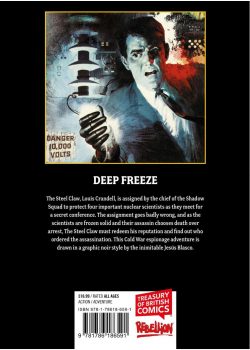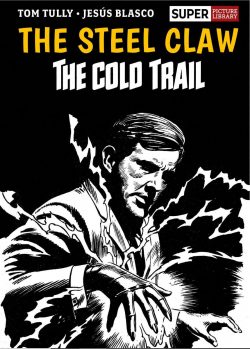

By Tom Tully & Jesús Blasco & various (Rebellion)
ISBN: 978-1-78618-659-1 (HB/Digital edition)
Another stunning salvo of graphic wonderment from Rebellion’s Treasury of British Comics strand, The Steel Claw: The Cold Trail is a sublimely engaging yarn celebrating an all-but-forgotten sub-strand of the 1960s comics experience.
Until the 1980s, comics in the UK were based on an anthological model, offering variety of genre, theme and character on a weekly – or sometimes fortnightly – basis. Humorous periodicals like DC Thomson’s The Beano were leavened by thrillers like the Q-Bikes, Billy the Cat or General Jumbo whilst rival publisher Amalgamated Press/Fleetway/IPCs comedy comics such as Whizzer and Chips always offered a thriller or two like Wonder Car or Pursuit of the Puzzler.
Similarly, adventure papers like Lion or Valiant always included gag strips such as The Nutts, Grimly Feendish, Mowser and a wealth of similar quick laugh treats. And yes, DCT installed equivalents in The Wizard, Victor, Hotspur and the rest…
Both companies also produced Seasonal Specials, hardcover Annuals and digest-sized anthology publications. DCT still publishes Commando Picture Library and used to sell romance, school dramas and a modern science fiction title (Starblazer) to match their London competitors’ successful paperback book titles.
Those ubiquitous delights included Super Picture Library, War Picture Library, Air Ace Picture Library and Action Picture Library.
These were half-sized, 64-page monochrome booklets with glossy soft-paper covers, but between 1967 and 1968 – at the height of the sixties Spy and Superhero booms – were supplemented by a deluxe, card-cover, 132-page version: The Fleetway Super Library.
As well as the always-popular war option of “Front Line” (starring by turn Maddock’s Marauders or Top-Sergeant Ironside), this line offered a “Secret Agent Series” – alternating cool espionage operatives Johnny Nero and Barracuda – and the “Stupendous” (formerly and briefly “Fantastic”) series which delivered lengthy complete sagas starring either The Spider or The Steel Claw.
These extra exploits came twice a month and ran 13 tales for each, with this spiffy hardback tome replaying the fifth release as crafted by the regular strip creative team of Tom Tully & Jesús Blasco …
British comics had a strange and extended love affair with what can only be described as “unconventional” (for which feel free to substitute “creepy”) heroes. So many of the stars and potential role models of our serials and strips were just plain “off”: self-righteous, moody voyeurs-turned vigilantes like Jason Hyde, sinister masterminds like The Dwarf, deranged geniuses like Eric Dolmann, jingoistic, racist supermen like Captain Hurricane and more often than not (barely) reformed criminals or menaces like Charlie Peace, the morally ambivalent Spider or The Steel Claw…
One of the most fondly-remembered British strips of all time is the eerily beautiful Steel Claw: created by Ken Bulmer & Blasco for the debut issue of weekly anthology Valiant. From 1962 to 1973, the stunningly gifted Blasco and his small studio of family members (plus occasional fill-in guest illustrators) thrilled the nation’s children, illustrating the angst-filled adventures of scientist, adventurer, secret agent and even costumed superhero Louis Crandell.
The majority of the character’s caseload was actually scripted by prolific and versatile comics writer Tom Tully (Roy of the Rovers, Heros the Spartan, Dan Dare, House of Dolmann, Janus Stark, Mytek the Mighty, The Wild Wonders, Nipper, Adam Eterno, Johnny Red, Harlem Heroes, Mean Arena, Football Family Robinson and many more).
He followed the precepts of H.G. Wells’ original unseen adversary which had been laid out by science fiction novelist Bulmer, presenting some modern spin on Victorian classic The Invisible Man.
In the 1960s, however, our protagonist acted with evil intent as soon as he fell out of sight of his fellow humans, but not through innate poor character, but because of wild technology accidentally unleashed…
The thrills of the writing are engrossing enough, but the real star of this feature is the artwork: captivating classicist drawing, moody staging and the sheer pristine beauty of all participants making this an absolute pleasure to look at.
Born in Barcelona in 1919, Jesús Monterde Blasco began his phenomenal career in 1935, drawing for Mickey magazine. Barely known now in the English-speaking world, his vastly varied output included Cuto, Anita Diminuta, Los Tres Inseperables, Los Guerilleros, Paul Foran, Tom Berry, Tex Willer, Tallafero, Capitán Trueno and Une Bible en Bande Dessinée for continental and South American audiences. His many UK strips include the lush and lavish Buffalo Bill, sci-fi chiller The Indestructible Man, Billy the Kid and the first Invasion! serial (2000 AD from #1, 1977). He died in October 1995.
What has gone before: Louis Crandell was an embittered man, presumably due to having lost his right hand in a lab accident. After his recovery and its replacement with an articulated steel prosthetic, he returned to work as assistant to venerable boffin Professor Barringer, who was attempting to create a germ-destroying ray.
When that device exploded, Crandell received a monumental electric shock and was bathed in radiation. Rather than killing him, the incident rendered him totally transparent whilst changing his body chemistry. Although he couldn’t stay unseen forever, the bodily mutation permanently affected him, and subsequent electric shocks caused all but his metal hand to disappear.
These were simpler times and there was far less SCIENCE around so please – Kids Of All Ages – do not try this at home!
Whether venal at heart or temporarily deranged, Crandell went on a rampage of terror, even attempting to blow up New York City before finally coming to his senses. Throughout Crandell’s outrages, guilt-fuelled Barringer was in pursuit, resolved to save or stop his former friend…
After he was caught and cured, the invisible man was so globally well known that he was framed by his own therapist. Whilst treating Crandell, Dr. Deutz was also traumatically exposed to Barringer’s ray but instead of invisibility, he gained the power to transform into a bestial ape-man and turned to crime for thrills. He malevolently placed the blame for his own spectacular robberies and assaults on his notorious patient…
On the run but innocent this time, Crandell was saved by the intervention of Barringer’s niece Terry Gray. After weeks of beast-triggered catastrophe and panic in the streets, the Steel Claw was vindicated and proved himself a hero. Despite that, a quiet life was clearly beyond the unseen celebrity, and while seeking anonymity in the Bahamas, he was embroiled in a modern-day pirate’s attempt to hijack an undersea super-weapon and plunder cruise ships…
A wilful recluse, Crandell underwent a gradual shift from victim to reluctant hero: accepting his powers and an elite if danger-ridden role at the fringe of society after he was recruited by a wing of British Intelligence dubbed “Shadow Squad”. The first thing the spooks did was to fake his death and publicly proclaim the Steel Claw was gone forever…
With them, Crandell foiled a deranged super-genius intent on eradicating human life and fought off an alien invasion for which see The Steel Claw: Reign of the Brain).
Crafted at the height of superspy media frenzy ‘The Steel Claw and the Cold Trail’ opens with a bored and idle Crandell taking stock of an improved metal hand and new abilities in first chapter ‘Hot Property’: fine tuning the new prosthesis before he’s given a crucial new mission.
For obvious operational reasons, Britain’s top four atomic scientists have never been allowed to occupy the same space at the same time. Now, however, they must convene in person for a crucial conference, and Shadow One wants Crandell to handle security, over the gents’ protests that he’s not qualified for this sort of mission…
His misgivings prove fatally correct when despite all precautions, the quartet are attacked and killed: frozen into blocks of ice by an assailant and method unknown to science. Thanks to his new ability to generate electrical shocks and magnetic waves, Crandell spectacularly chases and corners the assassin, but both the killer and his bizarre ray-gun are destroyed in the process…
Furious, frustrated and embittered, Crandell is placed on administrative leave and left to stew but he’s soon recalled in chapter 2 as ‘Deep Freeze’ reveals that three of the frozen corpses have been stolen. With the fourth about to be buried imminently, the super-agent heads for the funeral and arrives just in time to interrupt more distinctively-garbed assassins attacking the cortege and swiping the remains.
Employing his invisibility, Crandell tracks the villains to a cargo ship and sneaks aboard, but is eventually captured. To his amazement he learns that the scientists are still alive and that a cunning and cruel turncoat plans to defrost and sell them to a hostile power…
Left to die in the ship’s freezer, The Steel Claw soon ingeniously escapes and – anticipating by decades the movie Die Hard – methodically picks off the mercenary contingent. When the ship returns to dock, only the top traitor escapes…
The plot explodes into all-out action in ‘Slow Thaw’ as, rather than fleeing or hiding, the villain attempts one last bold assault to recapture his valuable cold cargo, resulting in a death duel with his invisible nemesis…
More than any other comics character, the Steel Claw was a barometer for reading fashions. Starting out as a Quatermass-style science fiction cautionary tale, the strip mimicked the trends of the greater world, evolving into a James Bond-style strip with Crandell eventually augmented by outrageous gadgets – and latterly, a masked and costumed super-doer after TV-triggered “Batmania” gripped the nation and the world. When that bubble burst, he resorted to becoming a freelance adventurer, combating eerie menaces and vicious criminals.
This is sheer addictive nostalgia for my generation, but the stories also hold up against anything made for today’s marketplace. Buy it for the kids and read it too; this is a glorious book, and steel yourself for even better yet to come…
© 1967, 2023 Rebellion Publishing IP Ltd. All rights reserved.
